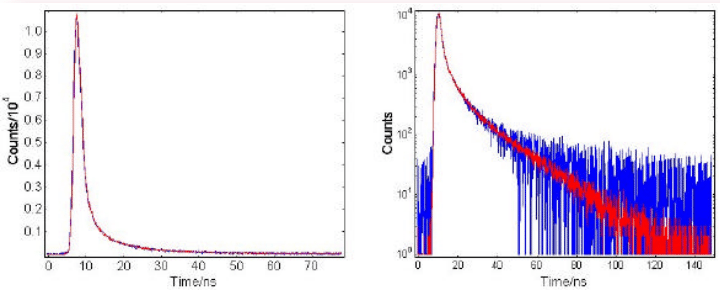Why use Time Correlated Single Photon Counting (TCSPC) for Fluorescence Lifetime Measurements?
Time Correlated Single-Photon Counting (TCSPC) is the method of choice for fluorescence lifetime measurements. The TCSPC technique outperforms all other techniques in sensitivity, dynamic range, data accuracy and precision.
Figure 1: Typical Fluorescence decay with Poission (red curves) and Gaussian noise (blue curves) shown in linear and logarithmic scale for comparison. It is obvious that the decay with Poission noise statistics allows for a much higher dynamic range.
Sensitivity:
TCSPC measures single photons, therefore detection is at the quantum limit. The technique requires an excitation source with high repetition rate pulsed output. As the process of capturing a single photon is repeated several thousand or even a million times per second, a sufficiently high number of single photons is processed for the resulting fluorescence lifetime measurement.
Only one photon is processed at a time, so the light pulses required for sample excitation have low pulse energy. This causes minimal sample degradation and avoids many non-linear sample effects.
Measurement:
TCSPC is a time domain technique. Data is accumulated, presented and analysed in a format showing signal intensity versus time, usually in picoseconds, nanoseconds, or microseconds. The presence of multi-exponential or more complex decay kinetics can be seen when viewed in a semi-logarithmic scale (fig. 1).
Time Resolution:
TCSPC provides the highest time resolution among techniques using single photon detectors. This distinguishes it from up-conversion, autocorrelation techniques and streak cameras. The distinct advantage of TCSPC is that this technique does not use the analogue detector response to produce the instrumental response function (IRF). The jitter in the rising edge of the detector analogue response dictates the width of the IRF. The rising edge jitter of photomultiplier detectors (caused by the photo-electron transit time spread) is typically only 10% of the analogue pulse.
Download the full Technical Note: Why use Time Correlated Single Photon Counting?
Why use Time-Correlated Single Photon Counting for Fluorescence Lifetime Measurements?
Products for Time Correlated Single Photon Counting
Edinburgh Instruments offers multiple solutions for the measurement of Time Correlated Single Photon Counting, including our FLS1000 Photoluminescence Spectrometer, and our FS5 Spectrofluorometer. To learn more about these products, why not contact a member of our sales team at sales@edinst.com.
Sign-Up for our Application and Technical Notes
If you have enjoyed reading our Technical Note, why not sign-up to our infrequent newsletter, and follow us on social media.









